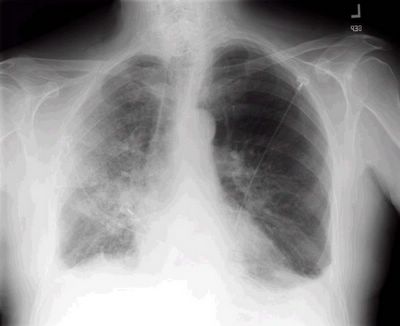This case was very interesting to me because we actually got Cx results in this patient. JH pointed out that she did not quite cut as "severe" pneumonia from the description and I think we all agree. However, she was getting there: age>65, underlying lung disease... Also with her structural lung Dz, she is at higher risk for AECB and LRTI's with GNRs. Indeed, she got somewhat worse before she got better: she dropped her Sats and BP and we were called to transfer her to the ICU. I added Cefepime to her regimen and she started growing GNRs from her admission blood Cxs.
She grew out Acinetobacter baumanii from her Cxs, improved with IVFs, BiPAP and ABTx and is now recovering.
We have seen a fair number of patients coming in from the community with odd GNR respiratory tract infections...
The CxR below is from a 72 y/o man who had come in with mild gallstone pancreatitis. We were asked to see him because of fever and pulmonary infiltrates and he grew a Sphingomonas paucimobilis (I'm not making it up) from blood and sputum...
Thursday, October 06, 2005
Subscribe to:
Post Comments (Atom)

3 comments - CLICK HERE to read & add your own!:
I'll put that one in the realm of "biologic organisms that I've never heard of."
I've never seen Acinetobacter causing CAP. However, as I said previously, I'd have a low threshold for adding/broadening out if the patient got worse, which is what happened.
Very interesting flora you've got down there...
I remember from a lecture by a prominent pulmonologist (FJM) that 10% of patients with an FEV1 < 50% predicted harbor pseudomonas as a colonizing bug.
So, if one bad GNR can colonize, why not another.
Do you know the FEV1 of the patient with acinetobacter?
Mike's point is what I was trying to lead to. Acinetobacter kind of trails Pseudomonas so if your lungs are bad enough to harbor one you may have the other too.
I dont' know her FEV1: she has smoked 2-3 ppd for >55 years but has nevere been referred to see pulmonary prior to this...
Post a Commenttest post a comment